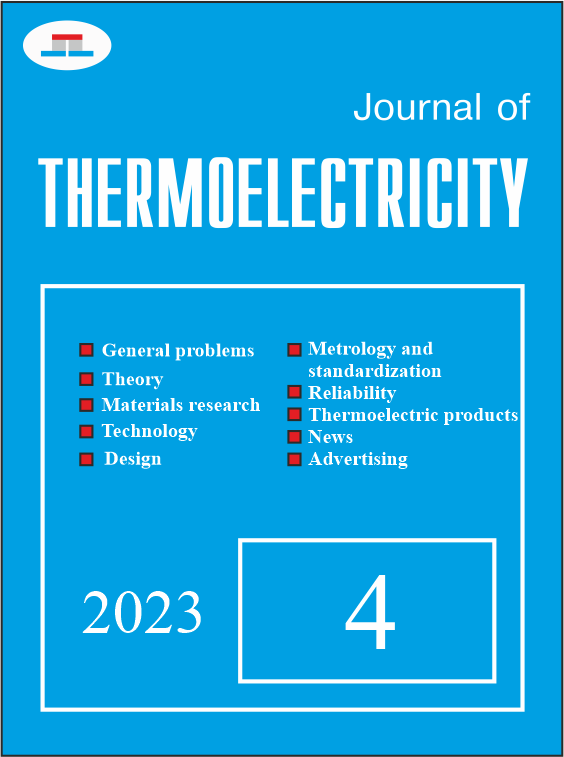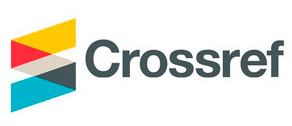Theoretical models of ordered alloys of thermoelectric materials based on Bi-Sb-Те
DOI:
https://doi.org/10.63527/1607-8829-2023-4-5-16Keywords:
theoretical models, chemical bond, effective radii, dissociation energy, state diagrams, non-equivalent hybrid orbitals (NHO)Abstract
Theoretical models of ordered alloys of promising thermoelectric materials of ternary systems based on Cd-Sb-Te have been developed.Using inverse triangulation methods, isothermal cross-sections and diagrams of the distribution of phase regions in ternary systems were constructed using binary state diagrams of the initial components (Cd-Sb; Cd-Te; Sb-Te).Calculations of the effective radii of interatomic interaction, electron density redistribution, and dissociation energy of the corresponding chemical bonds forming the Cd-Sb-Te crystal structure depending on the interatomic distances are presented.
References
1. Anatychuk L.I. (2003). Thermoelectric power converters. Institute of Thermoelectricity, Kyiv: Naukova Dumka.
2. Belotskij D.P., Manik O.N. (1996). On the relationship between thermoelectric materials melts properties and structures and the state diagrams. 1. Regularities of eleavage manifestation in the state diagrams. J. Thermoelectricity, 1, 21-47.
3. Belotskij D.P., Manik O.N. (1996). On the relationship of electronic properties and structures of melts to the diagrams of state in the thermoelectric material. 2. Phase changes and electronic properties of melts. J. Thermoelectricity, 2, 23-57.
4. Manyk О.М., Manyk T.O., Bilynskyi-Slotylo V.R. (2021). Theoretical models of ordered alloys of ternary systems of thermoelectric materials. 1. Chemical bond and state diagrams of In-Cd-Sb. J.Thermoelectricity. 2, 32-42.
5. Manyk О.М., Manyk T.O., Bilynskyi-Slotylo V.R. (2022). Theoretical models of ordered alloys of ternary systems of thermoelectric materials. 2. Chemical bond and state diagrams of Bi-Pb-Te. J.Thermoelectricity, 1, 5-15.
6. Ascheulov А.А., Manyk O.N., Manyk T.O., Marenkin S.F., Bilynskyi-Slotylo V.R. (2011). Peculiarities of chemical bond in cadmium. Neorganicheskie Materialy – Inorganic Materials, 47(9), 1052-1056.
7. Ascheulov А.А., Manyk O.N., Manyk T.O., Marenkin S.F., Bilynskyi-Slotylo V.R. (2013). Peculiarities of chemical bond in antimony. Neorganicheskie Materialy – Inorganic Materials. 49(8), 823-826.
8. Ascheulov А.А., Manyk O.N., Manyk T.O., Bilynskyi-Slotylo V.R. (2010). Molecular model and chemical bond in tellurium. Tekhnologiia i Konstruirovaniie v Elektronnoi Apparature - Technology and Design in Electronic Equipment, 89(5-6), 46-50.
9. Hansen M., Anderko K. (1962). Struktura dvoinykh splavov [Structure of double alloys]. Moscow: Metallurgizdat, v. 1,2 [in Russian].
10. Barchii I.E., Peresh E.Yu., Rizak V.M., Khudolii V.O. (2003). Heterogenni rivnovahy [Heterogeneous equilibria]. Uzhhorod, Zakarpattia Publ. [in Ukrainian].
11. Prikhodko E.V. (1973). Sistema nepolarizovannykh ionnykh radiusov i eio ispolzovaniie dlia analiza elektronnogo stroieniia i svoistv veschestv [The system of unpolarized ionic radii and its use for the analysis of the electronic structure and properties of substances]. Kyiv: Naukova Dumka [in Russian].




